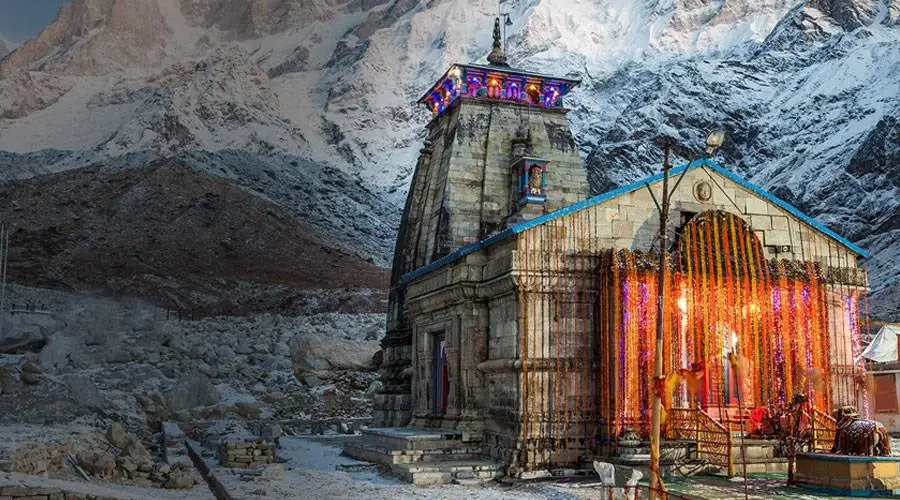Kedarnath Temple History
There are so many stories behind Kedarnath Temple’s History; it has been a pilgrimage center since ancient times. Although, it is not confirmed who built the original Kedarnath Mandir and when. A mythological story describes the temple’s construction by the legendary brothers Pandavas. But the holy Mahabharata does not mention any place called Kedarnath.
One earliest reference to Kedarnath is in Skanda Purana (7th and 8th century). According to Skanda Purana, Kedara is where Shiva releases the Holy Ganga from his matted hair (called in Hindi “Jata”).
Kedarnath Temple History
Hindu guru Adi Sankaracharya built the holy Kedarnath temple in the 8th century AD. Sankaracharya rebuilt the place where the Pandavas of Mahabharat fame is believed to constructed a shiv temple.
Pandavas Story About Kedarnath
According to mythology, Pandavas built the Kedarnath temple after Mahabharata. It is said that Pandavas wanted to go to Lord Shiva for forgiveness after killing their Kaurav brothers to make amends for their sins. But Lord Shiva did not want to meet them. That’s why Lord Shiva hid in Guptkashi.
Pandavas and Draupadi spotted a bull that was unique from the other bulls In Gupt Kashi. Pandav’s brother Bheem identified that the bull is none other than Lord Shiva himself. Lord Shiva was hiding from them in the form of Nandi, the bull. Bheem tried to catch the bull but couldn’t succeed, he only caught the tail of the bull.
Panch Kedar History
Lord Shiva, who disappeared from Guptkashi reappeared in five different forms in five different places.
These are hump at Kedarnath,
face at Rudranath,
arms at Tungnath,
navel, and stomach at Madhyamaheshwar and
the Hair locks (Jata) at Kalpeshwar.
And that’s how Panch Kedar came into existence.
Panch Kedar is evidence of Pandava’s story about Kedarnath Temple History. Lord Shiva was impressed by their efforts and hard work. Then he finally forgave them for their deeds.
Badrinath’s Story About Kedarnath Temple
Another legend is related to Nara and Narayana. Two incarnations of Vishnu went to perform severe penance in the Badrikashram of Bharat Khand (now known as Badrinath Temple) in front of a Shivalinga fashioned out of the earth.
Lord Shiva was pleased with their dedication and appeared in front of them and granted them a wish. Nar Narayan requested Shiva to stay there and make that place his permanent abode as a Jyotirlinga at Kedarnath for the welfare of humanity. Granting their wish, Lord Shiva stayed in that place which is now known as Kedarnath.
Other names of Lord Shiva are Kedareshwara and Lord of Kedar Khand aka Kedar Baba.
How Kedarnath Temple Survived Floods & Glacier Movements?
Geologists claim that the temple of Kedarnath was under snow for nearly 400 years, sometime around 1300-1900 AD, a period known as the Little Ice Age. Scientists from the Wadia Institute of Himalayan Geology, Dehradun, say the several yellow lines on the temple walls point to glacial activity in the region. The temple not only survived being under the snow for 400 years but also escaped any serious damage from glacial movement.
Scientists say that even the inside of the temple shows signs of glacial movement and the stones are more polished. The report further adds that scientists studied architecture and concluded that those who designed the temple not only kept in mind the terrain but also the formation of snow and glaciers, and ensured that the structure was strong enough not only to withstand natural disasters and the passage of time.
The Kedarnath Flood of 2013
In 2013, massive flash floods swept through Uttarakhand. The avalanche claimed 197 lives. About 236 were injured and 4,021 went missing. A total of 2,119 houses were fully damaged, 3,001 severely damaged and 11,759 partially damaged.
Kedarnath, the temple and town, also bore the brunt of nature's fury, but the shrine survived. Some say a massive boulder blocked the path of the water and saved the temple from being washed away. Miracles or just great architecture, the shrine survives and continues to attract the devout to this day.
Where is Kedarnath?
One of Hinduism's holiest shrines, the Kedarnath temple is located in Rudraprayag, in the lap of the Garhwal Himalayas, 221km from Rishikesh. It rests against the backdrop of the Kedarnath range, at an altitude of 3580m. It is one of the four sites that make up the Chhota Char Dham pilgrimage circuit, along with Badrinath, Gangotri, and Yamunotri. It is also one of the 12 Jyotirlingas or sites holy to Lord Shiva.
How to reach Kedarnath?
Gaurikund is the last motorable point before Kedarnath. From here, it's 14km up the mountains. One can walk up, ride a pony, or be hauled up in a palanquin. Alternatively, you can take a very short helicopter ride from Sirsi, Phata, or Guptakashi and then walk up the short distance to seek the blessings of Shiva.


Comments (0)